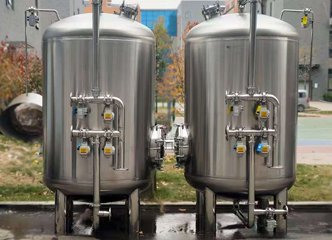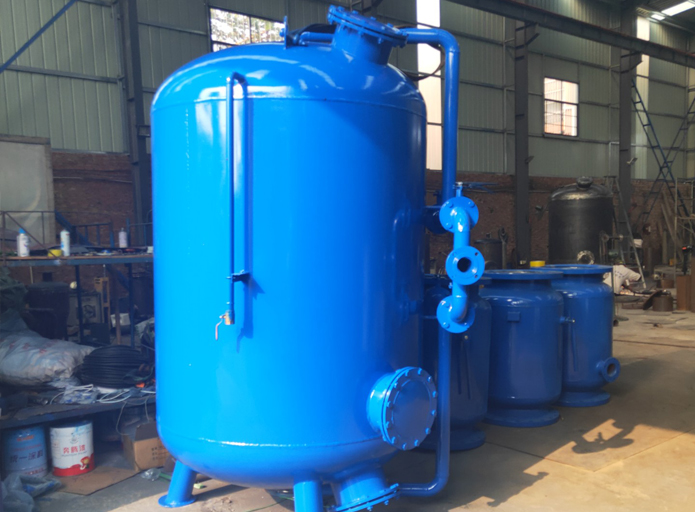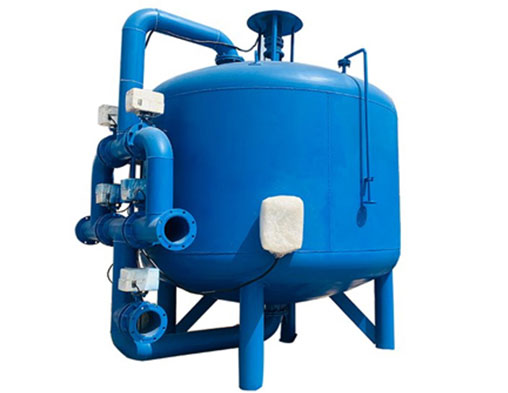As a complex industrial operating system, oil fields often produce large amounts of oily wastewater. Fiber ball filters are gradually widely used in oilfield oily wastewater treatment because of their unique properties. The following are detailed applications of fiber ball filters in oil fields:
Primary treatment of oily wastewater: During the oil field mining process, a large amount of oily wastewater needs to be treated. Fiber ball filters are hydrophilic and oil-resistant. When water passes through the fiber ball filter material, a water film will form on the surface of the fiber ball. The water film can effectively isolate grease and water, which can greatly improve the treatment efficiency of oily sewage.
Improve the accuracy of sewage treatment: Oil fields have increasingly higher requirements for sewage treatment. In order to meet this demand, modified fiber ball filter technology came into being. This technology can significantly improve the accuracy of sewage treatment, and the equipment has strong regeneration capabilities, saving a lot of space.
Interception and adsorption of suspended particles and impurities: The fiber filaments in the fiber ball filter have a tight structure and can effectively intercept and adsorb suspended particles, microorganisms, organic matter and other impurities in the sewage, thus ensuring the quality of oilfield reinjection water.
Used in boiler feed water treatment and circulating water side flow filtration: In addition, fiber ball filters are also widely used in boiler feed water treatment and circulating water side flow filtration. In addition, the fiber ball filter is not easy to stick to oil, is easy to backwash and regenerate, and has high filtration accuracy.
Finally, the fiber ball filter is simple, convenient and efficient to operate, and has strong mechanical strength and long-term use capability. These factors make fiber ball filters more and more important in oilfield wastewater treatment, which improves work efficiency and reduces operating costs for the environmental protection of oilfields.

The working principle of the fiber ball filter is quite unique and efficient. The process is explained in detail below
Production and structure of fiber balls: The production process of fiber balls mainly involves taking a bundle of short fibers and tightly ligating or hot-melt bonding them in the center, so that the short fibers form a radial spherical structure. The individual characteristics of this kind of fiber ball are that the fibers are densely packed in the center of the ball and gradually loosen toward the periphery. As the length of the fiber increases, the volume of the fiber ball also increases. Therefore, the holes on the periphery of the fiber ball also become larger, which is beneficial to increasing the filtration area and speeding up the filtration speed.
Filtration process: The filtration process is to pass the water to be treated through the inside of the filter. The impurities in the water are trapped on the surface or inside the fiber ball filter layer, and the clean water is discharged through the fiber ball. The detailed operation of this filtration process is: The fiber ball filter material is different from the traditional hard particle filter material. It uses elastic filter material with a large porosity. During the filtration process, the void ratio of the filter layer gradually becomes smaller along the top-down water flow direction, which is more in line with the ideal distribution of voids in the filter material with large top and small bottom.
Processing capacity: The upper part of the filter layer composed of fiber ball filter material is relatively loose, the fiber balls are still basically spherical, and the pores between the balls are relatively large. In the lower part of the filter layer, due to the hydraulic effect and its own gravity, the fiber balls are accumulated relatively densely. This structure helps improve filtration efficiency and trap more impurities.
Strong adaptability: The fiber ball filter has strong adaptability and can work in a wide range of temperatures and pressures. It has good elasticity, large gaps, long working cycle, and small head loss. During operation, appropriate adjustments can be made according to the water quality to achieve the ideal filtration effect.
The fiber ball filter has high filtration accuracy and strong decontamination ability, and plays a very important role in the water treatment process. Especially in the treatment of oily sewage reinjection, boiler feed water treatment, circulating water systems and water pollution control, it has a wide range of applications.

Fiber ball filters offer many significant advantages
High processing precision: The diameter of the filter material of the fiber ball filter can reach tens of microns or even several microns, so it has high filtration precision and can remove suspended particles of different sizes, and the removal efficiency can reach 100%. Moreover, it also has a strong removal effect on impurities such as colloids, bacteria, macromolecular organic matter, viruses, and iron.
Large adsorption surface area: The unique structure of the fiber ball gives it a large specific surface area and porosity, so it has a good adsorption effect. It can adsorb and intercept suspended particles in the water, giving full play to the deep pollution interception ability of the filter material.
Small filtration resistance: The fiber ball filter material has good elasticity, large gaps, and small water head loss, so the filtration resistance is small, the filtration speed is fast, and the processing capacity is large.
Wear resistance and strong chemical stability: Fiber balls have the advantages of not being easily stained with oil, wear resistance, and strong chemical stability. When the filter material is seriously contaminated by organic matter, it can also be regenerated using chemical cleaning methods, which is highly practical.
Easy operation and simple maintenance: The fiber ball filter is small in size, simple in structure and easy to operate. After careful design and manufacturing, it can not only remove most suspended particles and impurities, but also remove odor and color from the water, providing a healthy and clear water source.
Retain beneficial minerals: While filtering to remove impurities, fiber ball filters can also retain beneficial minerals in the water, making the water quality more balanced and healthy.
Widely used: Fiber ball filters can be used in the recycling and filtration treatment of various industrial circulating water and domestic water and wastewater, such as steel, thermoelectricity, shipbuilding, papermaking, medicine, chemical industry, textile, food, beverage, tap water, swimming pools wait.
The above advantages make fiber ball filters widely used in the field of water treatment. These advantages are also key factors that make fiber ball filters stand out in the highly competitive filter market.
The composition and structure of the fiber ball filter is quite complex and professional. The following is a detailed analysis
Cylinder: The steel circular cylinder is the main part of the filter. Its size and specification can be selected according to actual needs. It can withstand a certain pressure and carry the filter medium and the water body to be treated.
Water distribution system: The water distribution system is located at the bottom of the cylinder and is responsible for evenly distributing the water to be treated to the entire filter bed to ensure the effectiveness and efficiency of the entire filtration process.
Water collection system: The water collection system consists of water collection pipes set at the bottom of the cylinder and is used to collect and transport filtered clean water.
Fiber ball filter material: Fiber ball filter material is made of special fibers and treated with hydrophilicity and roughness. The resulting filter material is an accumulation of many fiber balls, which can effectively filter out various Impurities.
Backwash device: Backwash, that is, the cleaning process, is to remove contaminants attached to the surface of the filter material. The backwash device includes a top stirring mechanism and a fully automatic backwash control system, which can automatically perform backwash operations according to the set time or pressure difference, which not only saves labor, but also ensures the filtration effect.
Among them, fiber ball filters also have two forms: gas backwash and mechanical backwash, which can be selected according to actual needs and operating conditions. Gas backwash is usually used to treat oily sewage and can better remove oil pollution; mechanical backwash is more suitable for treating general water quality.
The above five parts basically constitute the basic structure of the fiber ball filter. Its main features are compact structure, integration, easy operation and maintenance, strong frame capacity, low pressure loss, good processing effect and long life.
In practical applications, fiber ball filters can be used with fiber ball filter materials of different materials or specifications according to the needs of filtration accuracy to complete the treatment of various types of sewage, satisfactorily solving the problem of processing high turbidity water sources. Made important contributions to environmental protection.

The work flow of the backwash device of the fiber ball filter is quite professional and delicate. Here's a more detailed explanation
Start backwashing: When the filter runs for a period of time and the pressure difference between the inlet and outlet reaches the preset value, it will start backwashing. The signal for the start of this work is usually the size of the pressure difference. When the pressure difference exceeds a certain range, it means that the pollution inside the filter has accumulated to a certain extent, and backwash cleaning is required.
Close the electric valve: Once the backwash is started, the electric valves of the water inlet and outlet of the filter tank will be closed. This is to prevent dirty water from flowing out into the clean water system during backwashing.
Start the stirring motor: After closing the electric valve, start the stirring motor and start backwashing the filter tank.
Backwashing stage: After the stirring motor is started, the fiber ball filter material will begin to loosen and expand under the action of the mixer. At the same time, the cleaning water is sprayed out from the bottom under a certain pressure to wash away the fiber ball filter material. During this process, the pressure on the filter material will be released, causing the filter material to expand and tumble under the action of stirring, so that the pollutants attached to the filter material are washed away.
End backwash: When the backwash time reaches a predetermined value, or the backwash water has been cleaned to a certain extent, the supply of the stirring motor and cleaning water will stop, marking the end of the backwash stage.
Resumption of filtration: After the backwash is completed, the fiber ball filter material will be tightly packed again due to pressure recovery. At the same time, the electric valves at the water inlet and outlet are reopened, and the filter resumes normal filtration work.
The entire backwash process is cyclical and is carried out regularly according to actual operating conditions and water quality conditions to ensure the filtration performance of the filter and extend its service life.








